The head of Apollo found last year dates to second.third century C.E.
It’s official, the head of Apollo found by students and faculty from the Aristotle University of Thessaloniki in Greece has been identified by researchers. Discovered in the remains of a marble statue in Philippi, an ancient Greek city, it was missing its nose and body, but has been officially confirmed as part of the marble statue of Apollo, one of the most important Greek gods and the son of Zeus and Leto.
Anastasios Tantsis, an archaeologist at the university, told All That’s Interesting’s Kaleena Fraga that, “The moment of the discovery was thrilling.”
“The students were really enthusiastic,” said Tantsis when the 1800-year-old head of Apollo found in Greece was confirmed. “We believe that even though these are moments of special importance for us too, sharing them with our students adds to the thrill.”

The team determined that the head, complete with a crown of laurels, dates to the second or early third century C.E. Researchers think it was part of a grand fountain that once stood at an intersection of two streets in Philippi, reports Arkeonews’ Oguz Buyukyildirim.
The group from the Aristotle University of Thessaloniki concluded that the head belongs to the early third or second century C.E., complete with a wreath of laurels. Oguz Buyukyildirim of Arkeonews wrote that researchers believe it was a portion of a grand fountain that had stood at the intersection of two streets in Philippi.

Apollo did not hold any lasting symbolic significance in Christian Philippi, in contrast to other Greek gods. The late Byzantine period (approximately the 13th to 15th century) is known to have seen the continuous use of classical and Roman-era statues to decorate public buildings. Therefore, the statue’s existence most likely indicates a celebration of the city’s fine artistry.
The site of the 1800-year-old head of Apollo found at the east of the southern main road in Philippi is the same location as the one where a statue of Hercules was found in 2023. The statue, which was mostly undamaged, showed a young, robust Hercules holding a lion and a club in his hands.
